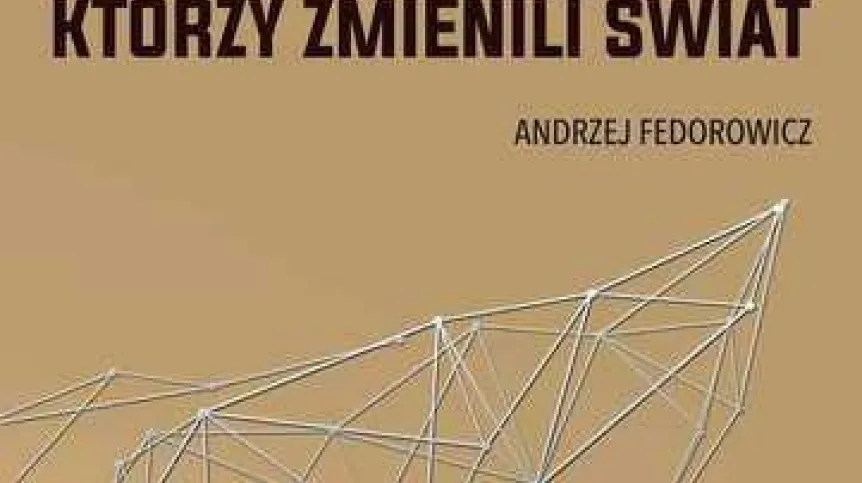
What do a bulletproof vest, a universal fireman\'s ladder and a windscreen wiper have in common? As it turns out - all these things have been created by Polish inventors. You can read about Polish discoverers, inventors and innovators - both less and more famous ones - in the book titled "25 polskich wynalazców i odkrywców, którzy zmienili świat" (25 Polish inventors and discoverers who changed the world).
Who among us, woken up in the middle of the night, wouldn\'t be able to recite the achievements of Nicolaus Copernicus, Maria Skłodowska-Curie or Ignacy Łukasiewicz? Anyone who has had any contact with the Polish education system, has those names imprinted in their head. We like to brag about the success of our compatriots, although the circle of people we brag about is still very narrow. There are many more interesting, important figures - but most of those are known only to specialists in a given field. Andrzej and Irena Fedorowicz fight this phenomenon in their new book "25 polskich wynalazców i odkrywców, którzy zmienili świat" (25 Polish inventors and discoverers who changed the world).
Already at first glance we can see something interesting in the table of contents: while the greatest figures of Polish science and inventions mentioned above are there, they are not distinguished in any way. They have not been given a separate section of the book, and the chapters devoted to them are surrounded by much less familiar names. I liked this device; it would be hard to omit our most famous scientists and inventors, but their presence absolutely does not have to be emphasized - their names speak for themselves. In the book itself none of the figures is presented as more important than the others. And by arranging chapters in random order, the authors leave the evaluation of importance of individual discoveries to the readers.
Large parts of the book are devoted to groundbreaking works that, as the authors argue, have changed the course of World War II. We can read about the mine detector built by Józef Kosacki - a device whose life was surprisingly long: since its debut in 1942 it remained in use without major design changes until 1995. In turn, Rudolf Gundlach\'s rotary periscope made possible something that seems obvious today: observing the battlefield by tank\'s crew. Walkie-talkie built by Henryk Magnuski allowed soldiers to communicate with each other during the Normandy landings or the Battle of the Ardennes. Warfare was also influenced by Tadeusz Sędzimir\'s metal-rolling technology, which made it possible to construct airborne radars for the US Army.
Military aspects are not the only subject of interest of the authors. Perhaps even more important are health-related discoveries. And so the reader can learn about how Ludwik Hirszfeld developed the method of determining blood type, Edmund Biernacki - a method of detecting inflammation of the body, and how Kazimierz Funk discovered the existence of vitamins. The authors also describe the history of Rudolf Weigl, who discovered a typhus vaccine. Production of the vaccine required breeding lice that fed on human blood - during World War II, in his laboratory in the occupied Lviv Weigl employed researchers, students and members of the resistance movement as lice "feeders", thus protecting them from being deported to Germany.
Among the 25 most prominent Polish inventors there are also people whose influence has emerged in other areas of life. For example, a very popular device in the early decades of the twentieth century was Kazimierz Prószyński\'s Aeroscope camera - the first hand-held film camera with image stabilization. Another Polish inventor was the author of an automatic rail collisions prevention system: in November 1857, the first such mechanism was installed on the Paris-Saint Germain line, developed by Jan Józef Baranowski. In turn, the famous pianist Jozef Hofmann, although for him inventions were just a hobby, in the early 20th century he designed the first windscreen wipers and pneumatic shock absorbers used in cars until the 1940s.
Many readers may have heard the story of Mieczysław Bekker. In his childhood he was an avid fan of Jerzy Żuławski\'s book "On the Silver Globe" - the first Polish science fiction novel (published just two years before Bekker\'s birth). Żuławski\'s book tells a story of a trip to the moon, long fragments of it describe a tedious journey through the lunar landscape - a journey with a special vehicle. It is not surprising, therefore, that as an adult, Bekker fulfilled his childhood dream: he became the pioneer of terramechanics and the constructor of the lunar rover. His vehicle\'s wheels first touched the surface of the Moon in 1971 during the Apollo 15 mission.
The list of inventors, scientists and inventions goes on. Their stories are fascinating. Authors present their heroes as brave and determined people - especially this determination seems to be their common feature. It is presented as a necessary trait: "apparently, it is part of being a Polish inventor or discoverer - their road is always more uphill" - the authors write in the introduction.
Regardless of whether or not we agree with such a dramatically expressed opinion, it can not be denied that the Fedorowicz\'s heroes are individuals whose stories are read with great admiration (and satisfaction when, as it happens in good stories, they gain fame and recognition of the people of their time).
In some places, unfortunately, the criteria the authors used when choosing the heroes of the book are a bit unclear. There are doubts as to whether the Polish origin alone - without mentioning any other connections with the country - is sufficient to call a person "Polish inventor/discoverer". This is precisely the case, for example, with the inventor of Kevlar, Stephanie Kwolek - the chapter devoted to her does not clarify why the engineer who spent her entire (not only professional) life in the US is mentioned among Polish inventors. While it is true that if we take into account the turbulent history of Poland and Polish people, it is sometimes difficult to determine whether a person can still be described in this way, it is the more important to set clear limits - and emphasize them in the text. This is what the authors have done in the case of the people of German origin who considered themselves Polish - it is a pity that this principle does not work the other way around.
It is also difficult to say why among countless young scientists and inventors, Dr. Patrycja Wizińska-Socha, inventor of a portable foetal heart monitor, has been honoured with her own chapter. With all due respect to the invention itself and its creator, it is difficult to assess the impact of a device on the quality of life just one year after its introduction to the global market - has it really "changed the world"? It seems that the only thing that can really be measured at this point is the recognition of the community. I think that I would prefer to read about Dr. Wizińska-Socha\'s device in another book, devoted fully to Polish inventors and innovators of our time.
The book "25 polskich wynalazców i odkrywców, którzy zmienili świat" will be published on July 3 by Fronda.
PAP - Science and Scholarship in Poland, Katarzyna Florencka
kflo/ zan/ kap/
tr. RL













